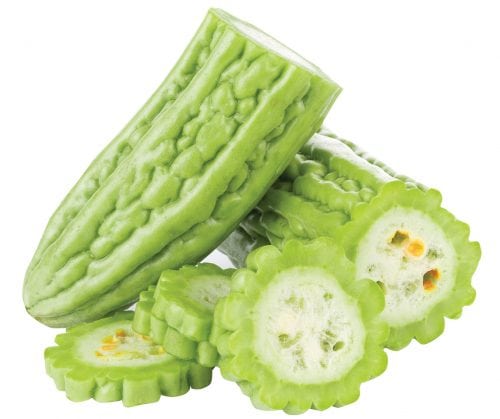
Bitter melon
Bitter melon, also called karela, bitter gourd or fu quas, is an unusual looking fruit, and the number of lumps and bumps on the skin varies depending on the variety.
To prepare bitter melon, remove the internal pith and seeds. To remove some of the bitterness, blanch in boiling water before cooking. Alternatively, salt the flesh and leave for 10 minutes, then rinse in cold water.
Commonly used in Asian cuisine, bitter melon is suited to stir-fries, stews or curries. Or stuff it with a mince or bean mixture and bake.
Bitter melon is a good source of vitamin C, with 31mg in 3/4 cup cooked, chopped melon – nearly half the amount in an orange.
Bitter melon is known for reducing blood sugar levels, so be careful of how much you eat, but don’t rely on it to help you come off diabetes medications.
Did you know? The seeds of bitter melon have a laxative effect, so don’t eat them.
Butternut squash
Butternut squash is a relatively new addition to the pumpkin family, originating around 1944. These days it is a popular vegetable in Kiwi households, due to its versatility and delicious sweet, nutty flavour. Because of its thinner skin and shape, butternut is much easier to cut than other pumpkin varieties.
Butternut is particularly nice roasted or stuffed. Add it to pasta or chicken bakes, frittatas, quiches, salads, curries and stews.
The yellow colour of the butternut squash shows it’s an excellent source of vitamin A.
Not only that, it’s an excellent source of vitamin E and a good source of magnesium, manganese and vitamins B6 and C. This is great news for your immune system, heart health and brain function.
Recipe ideas
Barbecued butternut and lamb salad
Stuffed butternut squash
Roasted butternut with tahini yoghurt
Apricots
Apricots, originally from Central Asia, are an excellent source of vitamin A, in the form of beta-carotene, which is great news for glowing summer skin and eye health. Three apricots provide you with 10 per cent of your daily fibre needs (3g).
Apricots are an easy-to-grow stone fruit, provided conditions are right. Trees enjoy a cold spell in winter to stimulate fruit production, and once they fruit are vulnerable to birds and diseases.
Apricots are delicious eaten raw or in salads, added to baking and desserts, or turned into jams and chutneys.
Did you know? Raw apricot kernels contain substances which can convert to cyanide in our bodies, so avoid eating these.
Recipe ideas
Grilled chicken with creamy potato salad and fresh apricot salsa
Orange, apricot and cashew bliss balls
Chocolate and apricot slice
Vanilla poached apricots
Fresh this month
(Harvested in New Zealand gardens in February)
Vegetables: Avocados, beans, beetroot, broccoli, cabbage, capsicums, carrots, cauliflower, celery, courgettes, cucumbers, eggplants, fennel, garlic, globe artichoke, kumara, lettuce, peas, potatoes, pumpkin, radishes, silver beet, spinach, spring onions, sweetcorn, tomatoes
Herbs: Basil, chives, coriander, dill, oregano, parsley, rosemary, sage, thyme
Fruit: Apples, blackcurrants, boysenberries, cherries, lemons, melons, nashi, nectarines, oranges, passionfruit, peaches, pears, plums, rhubarb, strawberries
www.healthyfood.com










